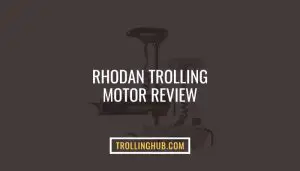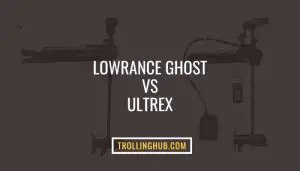
People mainly use their canoe as a traveling boat, carry passengers and equipment, and generally be faster on the water. Moreover, the most popular reason, they may set a trolling motor for trolling the fish. But how to mount trolling motor on canoe?
Anyway, it is not that much hard as it sounds. You will find three points for installing the trolling motor on your canoe. They are the transom, stern, and bow.
Yet, there are a few restrictions on the size and type of engine you may install. Canoes can use electric and gasoline motors, although electric engines are preferred as they are more delicate. Read till the end to find out more about it!
How to select the perfect trolling motor for your canoe
Always consider some facts when choosing the best trolling motor for canoe. They are essential for a perfect operation. Let’s have a look at them.
Type
Fishing and boating lovers generally use two common types of trolling motor. They are gas and electric trolling motors.
Electric motors can become a better relaxing moment without noise and smoke. But gasoline engines are more reasonable for comfort, speed, and those who travel long distances by boat. You may reach your destination quickly, refuel when required, and be back in a hurry.
Moreover, the electric trolling motors are rated in thrust pounds, not horsepower. But the gas trolling motors focus on the HP. In fact, they are perfect for racing or faster driving.
Both are good for you, but you have to choose one based on your decision. Remember that electric motors are more environmentally friendly than gas-powered motors.
What Size Trolling Motor For Canoe
How big of a motor can you put on a canoe? A fish lover needs to understand the actual size for a perfect setup. Here we will talk about the size chart comparing different factors. I hope it will help you a lot!
| Canoe length | 10’-12’ | 12’-14’ | 14’-16’ | 16’-18’ | 18’-20’ |
| weight | 500 lb | 750 lb | 1000 lb | 1250 lb | 1500 lb |
| HP | 5-10 HP | 10-15 HP | 15-20 HP | 20-40 HP | 40-75 HP |
| Pound of thrust | 20 lb | 30 lb | 40 lb | 50 lb | 60 lb |
| Performance thrust | 25 lb | 35 lb | 55 lb | 55 lb | 80 lb |
| Speed | 10-12mph | 12-14mph | 14-15mph | 15-20mph | 20-25mph |
| Engine Volt | 12v | 12v | 12v | 24v/12v | 254v |
Required Voltage
Voltage means the amount of load a given trolling motor will handle and the thrust achieved when charged. The electric motors are available in 12V, 24V, or 36V.
It means 12-volt deep-sea battery power the 12-volt trolley motor. The 24-volt motor needs to be powered by two different batteries, while the 36-volt model needs three.
The 12-volt trolling motor is the cheapest and most straightforward to operate. However, it lacks the thrust and strength you will get from the other two.
A 24 or 36-volt model will allow the fisherman to fish in the water for long periods as it requires fewer amps and provides more momentum for power. So, you can choose whatever you want.
Water condition
The saltwater trolling motors and freshwater trolling motors are different in their construction material. The salt in saltwater and sea air can damage some parts of the troll’s engine. So, the saltwater trolling motors have some additional protection and can resist corrosion.
Zinc, stainless steel, and magnesium used in various trolling motor equipment components can prevent long-term exposure to salt corrosion.
So the water source you’re primarily using in your canoe will determine the trolling motor you require. But don’t agonize; if you have to use a freshwater trolling machine in saltwater from time to time. It’ll not pay you that much.
On the other hand, freshwater trolling motors do not have those additional components. They are cheaper than the saltwater trolling motor and don’t provide similar support as a trolling motor in freshwater. So, the choice is yours.
Mounting options
There are mainly three mounting options in a trolling motor. You have to understand the best canoe motor mount for installing the engine properly.
Transom mount is a cheap trolling motor. It is easy to use, and the anglers should attach the bracket to the boat’s stern. You can do it with a simple clamping system. and operate with one hand without taking much space on the canoe.
Bow bases are placed on your boat’s bow. You will need to drill a hole to secure the bracket. Then create space for additional items like cables, hand devices, and pedals with which they are operated. Moreover, their steering system provides maximum flexibility and control.
A side mount is more prevalent than a bow mount for various reasons, most notably the alleviation you can control the kayak’s direction. The side mount provides easy hand access but has some disadvantages for anglers.
If you want to run a side mount motor, you may require a rudder to deal with any traction or tracking problems. Also, the side base will be an obstacle to movement if you try to fish on that side of the kayak. So, use one based on your preference.
Thrust
You can measure it by the energy required to move a canoe. Higher thrust comes from larger engines that allow use in fierce wind and waves. Think about the thrust you require, not too little or too much.
Propeller
A propeller is mounted directly on the propeller shaft of the engine. Therefore, engine power is transferred directly to your propeller without power loss. It improves performance, reduces bluster, and provides more precise control.
Shaft length
A shaft must be long to reach the water’s surface to have the best trolling motor performance. The perfect shaft length will be 1 ft under the waterline. So, purchase an adjustable length shaft to change the depth of the trolling motor for more satisfactory control.
How To Mount Trolling Motor On Canoe
To mount a trolling motor on the canoe, you need a right sized boat and trolling motors. You need to arrange the necessary tools and follow some rules to make your job done faster.
Equipments Needed While Mounting Trolling Motor On Canoe
- Newport vessels Trolling Motor
- Canoe motor mount bracket.
- Nuts
- Screwdiver
- ¼-inch drill bit
- Washer and more
Bow Mount: Better control your canoe
Bow mounts offer better control for your canoe. Let’s have a look at the ways to install them.
Step 1: Positioned your mount
Ensure the mounting bracket is snug against the motor for mounting the bow motor. Assure that you’ve positioned the base so that the engine has enough room to detach from the mount, and the mounting nails go into the deck. Anyway, it will not penetrate the hull.
Step 2: Drill holes in the deck
Pay attention to the holes that need to be drilled in the deck. You have to use your mount as a template. Then drill holes around 1/4″ deep, remove any debris, and insert a bolt into each hole of your mount base.
Step 3: Put the washer
Insert a washer into each bolt under the mounting bracket. Then insert the mounting bracket in the holes. Ensure the mount is flush with the deck, then screw the steel washer into each bolt to secure the motor and mount base.
Step 4: Finish it off
This motor must be about 5″ underwater. The trolling motor must be about 12 inches (30 cm) deep in water when fishing vertically with the engine running.
Transom Mount: Control the smaller boats
Transom motors are easier to install than the bow motor. You can just set it using a clamp in the stern of the boat. Now, explore the steps to install it.
Step 1: Place the trolling motor
Position your trolling motor close to the stern center and turn your clamps clockwise. It will close them, and the motor will remain attached to your boat’s back.
Step 2: Do it if you don’t want to use a clam
This procedure also works if you want to set the motor behind your boat when not centered on the stern. Make a part that runs through your canoe behind the seat. It should be measured in and built-in 2×4 format depending on the shape and size of the particular canoe.
How to Mount Gas Powered Trolling Motor on Canoe
Installing a gas powered trolling motor is quite easy. If you install it properly, you can enjoy fishing for so many hours.
Step 1: Determine everything
Choose the best engine that can fit your canoe with the right size and power. A gas-powered trolling motor gives the perfect service with some horsepower. Calculate the correct length of the canoe motor shaft and decide where to place the motor.
Step 2: Attach the trolling motor base
Screw and secure your trolling motor bracket and hang the engine base over your motor’s mounting base. Tighten the engine mounting bolts to the motor’s mounting base.
Step 3: Finish the process
Run the safety line through your trolling motor at a set point in the canoe. Check the engine configuration near the shore and a locator that may help you.
Trolling Motor On Canoe Laws
Attaching trolling motor to the boat is legal, but you have to comply with all standard boat security laws. Here we find some of them.
- All boats, except for non-motorized boats under 16 feet, canoes, racing, kayaks, or non-motorized rowing boats, regardless of size, must be recorded on the local tax agency’s external website.
- You must separate letters from digits by a space or hyphen equivalent to the width of the letter.
- You must carry the Registration Certificate on the panel and be available for verification by the Compliance Officer during the vessel’s operation.
- After purchase, you must number and register the canoe within 30 days.
- You must mark the registration numbers on the front half of your boat on both flanks above the water.
- You have to write the numbers in bold capital letters around 3 inches high, and the color contrasts with the hull.
- You must renew your boat’s registration certificate annually and place it within 15 cm before or after the port registration numbers (left).
When using Florida waters, vessels with papers without full state registration must be registered in Florida and have a validation label on the boat’s port side.
Canoe Trolling Motor Battery Setup
To get the most out of a trolling motor, you must connect it to some batteries used solely to power the engine. Trolling motors usually need 12, 24, or 36 volts, and any vessel owner can plug it in. Click here to learn how long does a trolling motor battery last.
Arrange the necessary tools
Before starting the process, arrange a wrench set, 40-50 amp circuit breakers, and 6-gauge jumper wires. Ensure that all system switches connected to the system are off.
For a 12V battery
Attach the 12V motor to the 12-volt battery with the black negative motor cable to the battery’s negative terminal. Then connect the red positive trolling motor cable to the positive battery terminal. Insert a circuit breaker (50 amp) into the positive terminal.
For a 24V battery
Attach the 24V motors with two 12V batteries by connecting the black negative cable from the motor to a battery’s negative terminal. Then connect the positive red cable from the motor with the positive terminal of another battery.
Insert a circuit breaker (40 amp) into this positive terminal. Join a jumper wire to the first battery’s positive terminal and the second battery’s negative terminal.
For 36V battery
Attach the 36V motors with three 12V batteries connected in series. Connect the motor’s black motor negative cable to the first three battery’s negative terminals. Then connect the trolling motor’s red positive cable to the third battery’s positive terminal.
Insert a circuit breaker (40 amp) into the positive terminal. Now attach two jumper cables to the system, from the first battery’s positive terminal to the second battery’s negative terminal and from the second battery’s positive terminal to the third battery’s negative terminal.
FAQs
How to register a canoe with a trolling motor?
To register, check the canoe registration conditions in your country. Complete the registration form online or in person.Provide ownership proof, including bill or invoice. Then pay the fee for registration, which depends on the state and boat size. Pay attention to the cessation date and request an extension.
How fast will a trolling motor push a canoe?
The speed of a trolling motor to push a canoe is about five mph, but it depends on the thrust pound. A canoe with 60 trust pounds can go 20-25 mph. However, the battery power and horsepower control the speed.
Can you put a trolling motor on the side of a canoe?
Yes, you can. It depends on the trolling motor you are using and your canoe. You can mount your trolling motor to the boat side with a clamp most of the time.
Final Thoughts
To enjoy the most fishing, you have to know how to mount a trolling motor on canoe. Remember that the perfect position is the transom. Side bases and bow bases have unique installation options.
The setup is in sync if your canoe’s rear is square, as the rear deck is a place to mount your trolling motor. It is excellent as you don’t need to do extra work to securely support your chosen trolling motor’s weight.
Still, if you have anything to know, contact us directly. Happy fishing!



